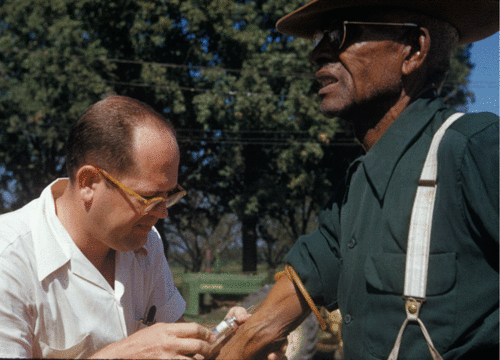1.9 人类主题研究
章节大纲
-
The Tuskegee Study: How It Began
::Tuskegee研究:如何发展It began in 1932 with good intentions. Two samples of poor African-American men in Alabama would be followed for six months to identify the effects of syphilis — a sexually transmitted bacterial infection — on their health. One sample included 399 African-American men who already had syphilis when the study began, and the other sample included 201 men who did not have the disease. The latter group served as a control. The purpose of the study, which was sponsored by the U.S. Public Health Service, was to justify syphilis treatment programs for African-American men. The study was called the Tuskegee Syphilis Study because it was carried out with the help of the Tuskegee Institute. It involved repeated tests and other data collection from the human subjects.
::它始于1932年,其用意良好。在阿拉巴马州,两个非裔美国人贫穷男子的样本将跟踪6个月,以确定梅毒(一种性传染细菌感染)对其健康的影响;一个样本包括399名在开始研究时已经患有梅毒的非裔美国人,另一个样本包括201名没有染上梅毒的男子,后一组样本起到控制作用。这项研究由美国公共卫生局赞助,目的是为非裔美国人梅毒治疗方案辩护。这项研究被称为Tuskegee Syphilis研究,因为它是在Tuskegee研究所的帮助下进行的,涉及反复测试和从人类主体收集其他数据。Using Human Subjects in Scientific Research
::在科学研究中利用人的主题In 1932, there were no guidelines or laws protecting human subjects in scientific research. The Tuskegee study was the prime mover in the adoption of such guidelines and laws. It violated several basic ethical standards in its treatment of human subjects and eventually became known as the most infamous biomedical study in U.S. history. The Tuskegee study provides a good model for how not to do research involving human subjects. How did the Tuskegee study go so wrong? And how did it ultimately lead to the protection of human subjects?
::1932年,在科学研究中,没有保护人类研究的指南或法律,Tuskegee研究是采用这种指南和法律的主要动因,在治疗人类研究时违反了若干基本伦理标准,最终成为美国历史上最臭名昭著的生物医学研究。Tuskegee研究为如何不进行涉及人类研究提供了一个良好的模式。Tuskegee研究是如何出错的?它最终如何导致保护人类研究?The Tuskegee Study: How It Went Wrong
::Tuskegee研究:它是如何错的There were problems with the Tuskegee study from the start. For one , the infected men were not told they had syphilis. The researchers told them they had "bad blood," a local term for various illnesses including anemia and fatigue, in addition to syphilis. The men were also not treated for syphilis. W hen the Tuskegee study began, there was no known cure for syphilis. Antibiotics were just being discovered, so there was little that could have been done to treat the syphilitic subjects in the study.
::Tuskegee研究从一开始就存在问题。 首先,被感染的男子没有被告知他们得了梅毒。 研究人员告诉他们,除了梅毒之外,他们有“ 坏血 ” , 包括贫血症和疲劳症在内的各种疾病的当地术语。 这些人也没有梅毒治疗。 当Tuskegee研究开始时,没有已知的梅毒治疗方法。 抗生素刚刚被发现,因此在研究中治疗非哲学科目方面几乎无所作为。The Tuskegee study was originally planned for just six months, but it actually went on for 40 years! During all those decades, the subjects were never actually treated for syphilis, even after 1945, when penicillin was being widely used to cure the infection and treatment clinics were set up nationwide. In fact, Tuskegee study subjects were prevented from receiving or even learning about penicillin. The failure of researchers to inform and treat the patients in their study were serious ethical violations. Not only did most of the men in the syphilis group die of their disease, but they also unwittingly spread it to their wives, some of whom gave birth to children with congenital syphilis.
::Tuskegee研究最初只计划6个月,但实际上持续了40年。 在所有这些几十年中,即使1945年之后,这些研究对象也从未真正接受梅毒治疗,当时青霉素正在被广泛用于治疗感染,治疗诊所也在全国范围内建立起来;事实上,Tuskegee研究对象无法接受甚至学习青霉素;研究人员未能在研究中告知和治疗病人是严重的道德违法行为;不仅梅毒组的多数男子死于他们的疾病,而且他们还不知不觉地将其传播给妻子,有些妻子生下了先天性梅毒。In the 1960s, a whistle-blower involved in the Tuskegee study reported the ethical violations, but the study was allowed to continue (see photo ). It wasn't until details of the study were leaked to the press in July of 1972 that the Tuskegee study finally came to an end. The July 26 issue of the New York Times featured the story of the Tuskegee study on its front page, and it captured national attention. The study was formally discontinued in November of the same year.
::20世纪60年代,参与Tuskegee研究的一名告密者报告了违反道德的行为,但允许继续这项研究(见照片 ) 。 直到1972年7月向新闻界透露研究细节之后,Tuskegee研究才最终结束。 7月26日的《纽约时报》头版刊登了Tuskegee研究的故事,引起了全国的注意。 这项研究于同年11月正式停止。The Tuskegee study was still going strong in the 1960s. The doctor pictured here is giving a subject an injection of a placebo. Impact of the Tuskegee Study: Protection of Human Subjects
::Tuskegee研究的影响:保护人类主题The shocking story of the Tuskegee study provided the impetus for new laws and agencies designed to protect human subjects in scientific research. In 1974, the U.S. Congress passed the National Research Act. The act required the creation of Institutional Review Boards to ensure human subjects are protected at institutions receiving federal funds for research. It also established strict guidelines for the treatment of human subjects in clinical research, including the following:
::1974年,美国国会通过了《国家研究法》,要求设立机构审查委员会,以确保接受联邦研究基金的机构保护人类研究。-
All subjects must give their informed consent to participate in a study. Potential participants must be informed of the real nature and purpose of the study. They must be given all the facts, including any potential risks, so they can make a fully informed decision about whether to participate.
::所有主体都必须在知情的情况下同意参加一项研究,必须告知潜在参与者这项研究的真实性质和目的,必须向他们提供所有事实,包括任何潜在风险,以便他们能够就是否参与作出完全知情的决定。 -
Subjects must always be able to quit a study. For example, if a new effective treatment becomes available, subjects must be informed and decide whether to receive the treatment or continue in the study.
::研究对象必须始终能够退出研究,例如,如果有新的有效治疗,必须告知研究对象,并决定是接受治疗还是继续研究。 -
Knowledge gained from a study must be weighed against the risks of the study for the participants. If the risks outweigh the potential knowledge gained, then a study is not ethically justified.
::从一项研究中获得的知识必须与研究对参与者的风险进行权衡,如果风险大于潜在知识,那么一项研究在道德上是没有道理的。
Rights of Human Subjects
::人权问题:人权问题In 2010, The U.S. National Institute of Justice published the following list of recommended human subjects' rights. From the list, you can see how far we have come in the protection of human subjects since the Tuskegee study ended in 1972. Human subjects now have the right to:
::2010年,美国国家司法研究所公布了以下推荐的人类主体权利清单。从这份清单中,你可以看到自1972年Tuskegee研究结束以来,我们在保护人类主体方面取得了多大进展。人类主体现在有权:-
voluntary and fully informed consent
::自愿和完全知情的同意 -
respect as autonomous agents
::尊重作为自治机构的权利 -
end participation in research at any time
::最终参与任何时间的研究 -
have their integrity safeguarded
::其完整性得到保障 -
participate only when benefits outweigh costs
::只有在收益超过成本时才参与 -
protection from physical, mental, and emotional harm
::免遭身心和感情伤害的权利 -
access to information regarding the research
::获得关于研究的资料 -
protection of privacy and well-being
::保护隐私和福祉
Tuskegee Study: Follow Up
::Tuskegee研究:后续行动In 1974, the U.S. government made reparations to the Tuskegee study subjects and their families. The government paid a total of $10 million and also promised lifetime medical benefits and burial services to all living participants and their dependents.
::1974年,美国政府赔偿了Tuskegee研究对象及其家人。 政府总共支付了1 000万美元,并承诺向所有有生命的参与者及其家属提供终生医疗福利和丧葬服务。In 1997, U.S. President Bill Clinton formally apologized and held a ceremony at the White House for surviving Tuskegee study subjects. Five of the remaining eight surviving subjects attended the ceremony, where Clinton said:
::1997年,美国总统比尔·克林顿正式道歉,并在白宫为Tuskegee幸存的学习科目举行仪式。 剩下的8个未亡科目中有5个参加了仪式,克林顿在仪式上说:"What was done cannot be undone. But we can end the silence. We can stop turning our heads away. We can look at you in the eye and finally say on behalf of the American people, what the U.S. government did was shameful, and I am sorry..."
::“我们所做的一切是无法挽回的。但是我们可以结束沉默。我们可以停止把头转掉。我们可以看着你的眼睛,最后代表美国人民说,美国政府所做的一切是可耻的,我很抱歉......”The last Tuskegee study subject died in 2004. That same year, the CDC gave $10 million to support the work of the Tuskegee National Center for Bioethics in Research and Health Care, a fitting memorial.
::最后一个Tuskegee研究课题于2004年逝世,同年,疾病防治中心拨款1 000万美元支持Tuskegee国家生物伦理研究和保健中心的工作,这是一个合适的纪念碑。Summary
::摘要-
The Tuskegee Syphilis Study was the prime mover in the adoption of U.S. guidelines and laws to protect human subjects in scientific research.
::Tuskegee Syphilis研究是美国通过准则和法律以保护科学研究中的人类主体的主要推动者。 -
The story of the Tuskegee study came to light in 1972, and the public reaction led to its termination that same year. In 1974, the U.S. Congress passed the National Research Act, which created Institutional Review Boards to monitor human subject research and guidelines (such as informed consent) for the treatment of human subjects in clinical research.
::Tuskegee研究的故事在1972年曝光,公众的反应导致其于同年终止。 1974年,美国国会通过了《国家研究法 》 。 该法案设立了机构审查委员会,以监测人类主题研究以及临床研究中治疗人类主题的指导方针(如知情同意 ) 。 -
In 2010, a list of human subjects' rights was published, which expanded subject's rights even more.
::2010年,出版了一份人权主体权利清单,进一步扩大了主体权利。
Review
::回顾1. Describe how the Tuskegee Syphilis Study began. What was its purpose?
::1. 描述Tuskegee梅毒研究是如何开始的,目的是什么?2. Identify ethics violations in the treatment of human subjects in the Tuskegee study.
::2. 在Tuskegee研究中查明在对待人的问题时违反道德的行为。3. Explain the role the media played in ending the Tuskegee study.
::3. 解释媒体在结束Tuskegee研究方面发挥的作用。4. What is informed consent?
::4. 什么是知情同意?5. List four other rights of human subjects.
::5. 列出其他四项人权主体的权利。6. Do you think that using the first name of a human subject in a published research article is a violation of their rights? Why or why not?
::6. 你是否认为在发表的研究文章中使用人名是侵犯他们的权利?为什么或为什么不是?7. Federal regulations now require that research funded by the U.S. government must have additional protections for “vulnerable populations”, which include children, prisoners, pregnant women, mentally disabled people, and economically or educationally disadvantaged people. Given the human subjects protections described in this section, explain why:
::7. 联邦条例现在规定,由美国政府资助的研究必须为 " 弱势人口 " 提供额外保护,其中包括儿童、囚犯、孕妇、精神残疾者、经济或教育处境不利者。a. Mentally disabled people are considered particularly vulnerable in research studies.
::a. 在研究研究中,精神残疾者被认为特别易受伤害。b. Children and pregnant women are considered particularly vulnerable in research studies.
::b. 在研究研究中,儿童和孕妇被认为特别容易受到伤害。c. Prisoners are considered particularly vulnerable in research studies.
::c. 在研究研究中,认为囚犯特别容易受到伤害。d. Excessive payment as compensation for participation in human subjects studies is not allowed.
::d. 不允许对参加人类学科研究给予过多的补偿。8. A proposed research study plans on testing college students with a drug to treat acne. In an earlier pilot study, some subjects experienced serious side effects, such as heart attack and stroke. Do you think this newly proposed research study adheres to human subjects protections regulations? Why or why not?
::8. 一项拟议研究计划,旨在测试大学生使用一种药物治疗,在早先的一项试点研究中,一些科目受到严重的副作用,如心脏病和中风,你认为这项新提议的研究符合人类主题保护条例吗?为什么或为什么没有?9. True or False: Researchers must protect human subjects from psychological harm.
::9. 真实或虚假:研究人员必须保护人类主体免受心理伤害。10. True or False: Human subjects must be told the purpose of the study that they are participating in.
::10. 真实或假:必须告知人类主体他们参与研究的目的。Explore More
::探索更多Watch this TED talk to learn about some current ethical issues in human subjects research:
::观看TED的演讲, 学习人类主题研究中当前一些伦理问题:To learn more about the Tuskegee Syphilis Experiment, check out this video:
::更多了解图斯克基梅毒实验, -
All subjects must give their informed consent to participate in a study. Potential participants must be informed of the real nature and purpose of the study. They must be given all the facts, including any potential risks, so they can make a fully informed decision about whether to participate.

